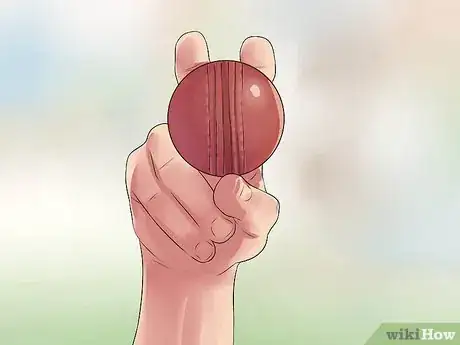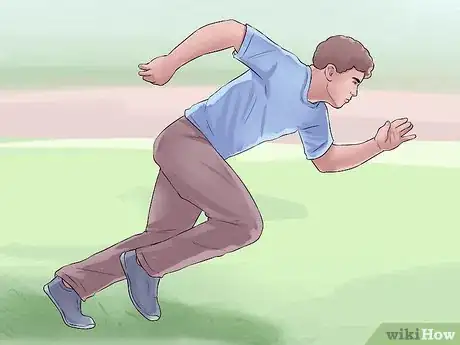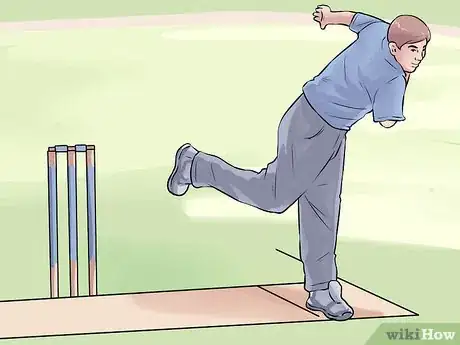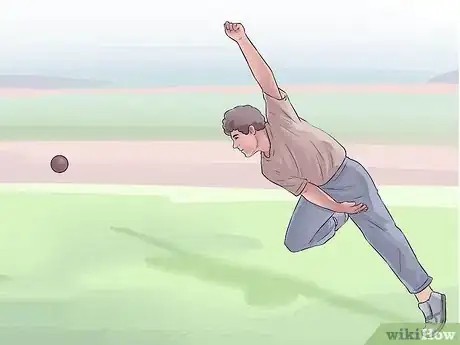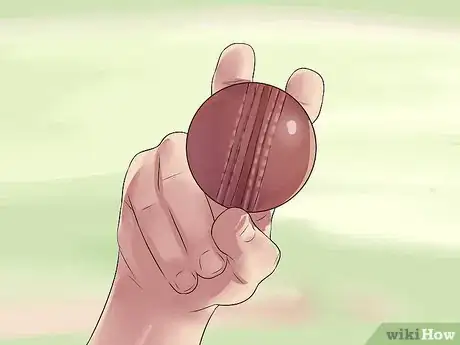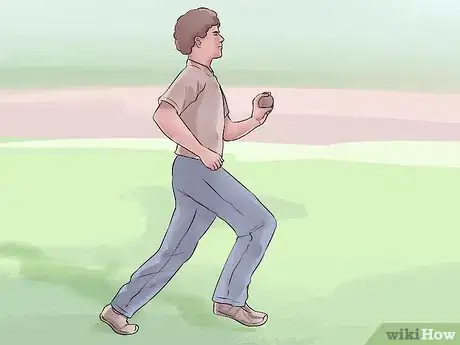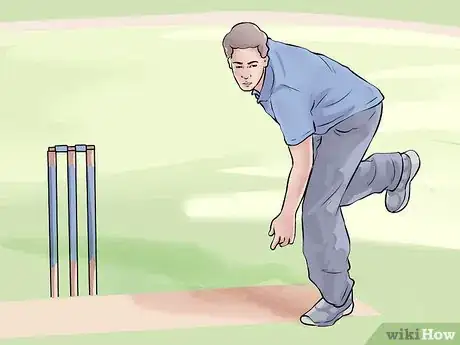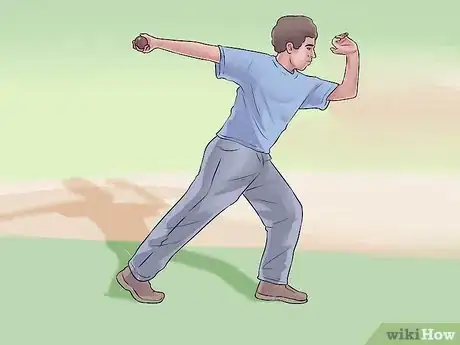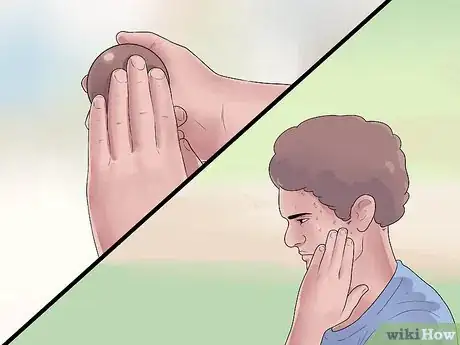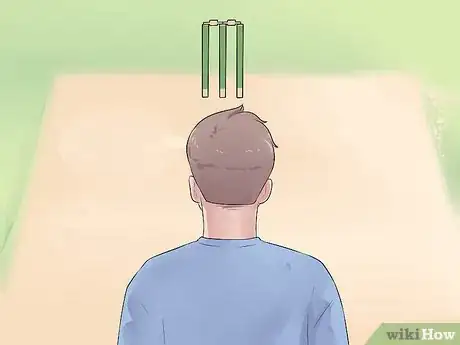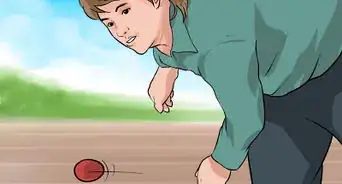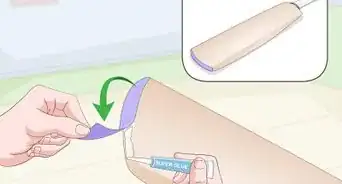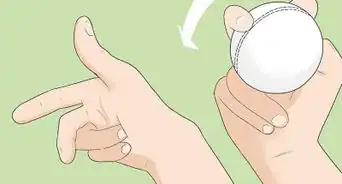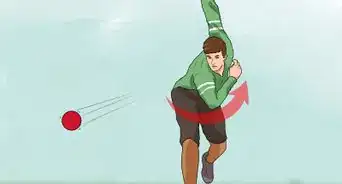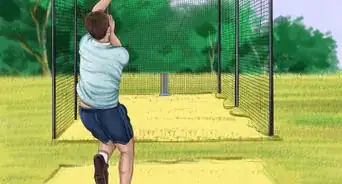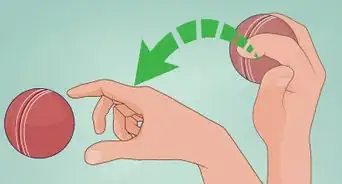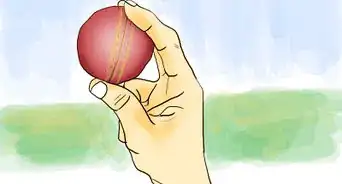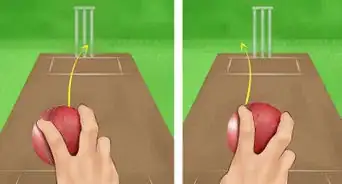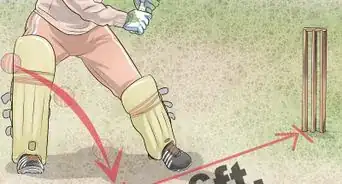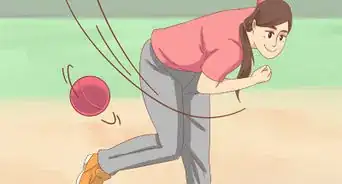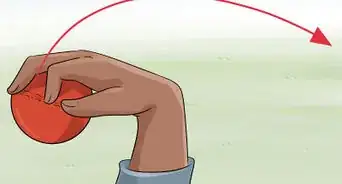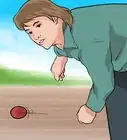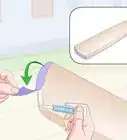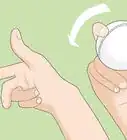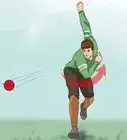This article was co-authored by wikiHow Staff. Our trained team of editors and researchers validate articles for accuracy and comprehensiveness. wikiHow's Content Management Team carefully monitors the work from our editorial staff to ensure that each article is backed by trusted research and meets our high quality standards.
This article has been viewed 190,363 times.
Learn more...
In cricket, bowling is the motion of propelling the ball toward a wicket, which is defended by a batsman. If you want to enhance your technique, learning how to bowl a great Inswinger is an important skill. The Inswinger is a lethal bowling technique you can use to get a right-handed batsman out LBW[1] (Leg Before Wicket) or just clean bowl him. The Inswinger can also be deadly to the left-handed batsman, as it forces them to play the ball away from their body.
Steps
Bowling an Inswinger Front-On
-
1Position the ball with the seam straight up and down.[2] As a front-on bowler, the seam should be entirely vertical.
- Put your first two fingers close together at the top of the ball on the seam.
- Rest your thumb on the seam underneath the ball.
- Make sure that you angle the shiny half of the ball away from the batsman. The rough side needs to face the direction you want to swing it.
-
2Start your run-up. The run-up in the preparation a bowler makes for delivery as he builds momentum and approaches the crease, which is demarcated by a painted line. Run quickly toward the line to create the maximum amount of momentum possible, while still allowing you to stay in control of your ball, body, and posture. Front-on bowling often uses a high speed run-up.[3]
- Swing bowling is a type of pace bowling, and in this type of bowling, the run-up has been shown to contribute almost 20% of the ball’s velocity. It's important to run quickly.[4]
- In cricket, the length of your run-up is a personal part of the game. Many great cricket players have different approaches to the run-up, approaching from different distances and angles. Practice to figure out what feels most natural.
- As you are running and when you land, keep your weight in the balls of your feet.[5] This will increase your speed and give you great control over your movements.
- When you are running, utilize your back. Before you reach the crease, bend backwards so that you will be able to create a stronger forward momentum at the moment of delivery.
Advertisement -
3Execute your delivery stride. During the run-up, the delivery stride begins three or four strides before the crease. In these final few steps, acceleration stops, and your pace should remain steady. Your footwork is an important part of creating a smooth delivery.
- As a front-on bowler, in the very last step before you deliver the ball, land with both your feet pointed toward the wicket, in other words, in the direction the ball will travel.
- Though both your feet are pointed in the same direction, your dominant foot should be positioned in the back, to give you leverage when you release. Usually, right-handed bowlers use their right foot as the back foot.
-
4Set up your body. Like your footwork, your body positioning is an important aspect of successful delivery. As a front-on bowler, you will look down the inside of your bowling arm to sight the target. Place your non-bowling arm to the side of your head.
- Your hips and shoulders should be open wider than 180 degrees.
- Usually, the non-bowling arm is held vertically right before the delivery motion.
-
5Release the ball. After you reach the crease, it’s time to deliver the ball. At the point of release, you will be directly facing the batsman.
- Make sure your delivery arm is stiff, rather than bent. You want to maintain a relaxed wrist but keep the position of your grip.
- Release the ball at the highest possible point for maximum swing. Use the downward motion of your non-bowling arm to create additional power.
- Run through the crease. Many front-on bowlers continue through the crease after they release the ball. This allows for a stronger release and a continuity of movement.
Bowling an Inswinger Side-On
-
1Get your ball into position. As a side-on bowler, hold the seam at an angle. It should point toward the fine leg position in the field.
- Your top two fingers should rest close together on the top of the ball with your middle finger directly on the seam. Your thumb should rest on the bottom of the ball at the seam.
- Position the shiny side of the cricket ball away from the batsman.
-
2Begin your run-up. The run-up is the period of running before release at the crease, which is a white line marked on the field. In cricket, the run-up is essential in creating the velocity of the ball, and in turn, performing an outstanding Inswinger.
- Every bowler approaches run ups differently, and there is no determined right or wrong length for a run up. Practice running up from different distances and angles to see what feels most natural.
- The length of the run up depends on how long you need to achieve your maximum force without losing control over your form.
- In general, side-on bowlers tend to favor a slower run up speed.
-
3Set your feet. The last few paces before you reach the crease are the delivery stride. In this stride, you should seek to maintain your speed without accelerating. As you reach the crease, the positioning of your feet is important.
- As a side-on bowler, your feet should stop parallel to the crease. You should maintain a comfortable width between them.
- At the moment of delivery, you should transfer your weight from your back foot to your front foot. For a right-handed bowler, the back foot is usually the right foot.
- The majority of your weight, during the run up and when you land, should be in the balls of your feet. This will assure you have maximum control over your movements.
-
4Position your body. The way you set up your posture during delivery can make or break your Inswinger. As a side-on bowler, in the last step before you release the ball, you should turn your body so that your left shoulder points toward the batsman. To align your shoulders with your hips, your non-bowling arm should be in front of your head.
- Usually, the non-bowling arm is held vertically before the release of the ball. Keep the ball in your bowling hand close to your head.
- Rotate the front arm high, and sight your target on the outside of your front arm.
-
5Deliver the ball. In this moment, you want to make sure you release the ball from the highest vantage point that you can.
- Make sure your delivery arm is stiff rather than bent. You want to maintain a relaxed wrist but keep the position of your grip.
- To create this movement, use both of your arms. The movement should look like the beginning of a cartwheel.
- When you are transitioning your weight onto your front foot, engage your whole body. Use the bend in your back to create additional momentum.
Perfecting Your Technique
-
1Keep your ball in great condition. When bowling an Inswinger, it’s important to make sure you have a good ball.
- Shine your ball after every bowl. Use your saliva or sweat on the shiny side of the ball, and then polish it on your clothes. Make sure you don’t get other substances on the ball, like sunscreen, as this can ruin the leather.
- Shining the ball helps it to swing effectively because the smoother side lets air flow around it more easily than the rougher side, and so it creates a better swing.
-
2Play with the length of your run up. It can take time to find the run up that feels the most comfortable for you. Take some time to do drills, and try different techniques.[6] Give yourself time to create a habit.
- Enlist the help of a friend or coach. In a field or even in your yard, mark out a starting point for your practice run-up. With the ball in hand, start at this point.
- With your eyes closed, run until it feels right to release the ball, but don’t actually deliver your ball. Have your friend mark where you stop. Repeat this around 15 times until a pattern begins to emerge. Count the number of strides it takes you to get to the point at which you have been stopping.
- This exercise will help you determine a run-up that is natural for you.
-
3Practice alone. You don’t need a coach or team to practice your Inswinger technique.
- Try setting up a simple stake in the ground, made from a branch, to show you where the batsman would be.
- Use a piece of rope or duct tape as the crease, so you know when to deliver the ball and can practice your run-up properly.
-
4Build your general strength. Like any sport, being a skilled cricket player requires a level of athleticism.
- Work on your arm strength by doing simple weight lifts and push-ups every other day.
- Make sure you keep up your cardiovascular strength by running moderate distances. This will help to improve your stamina.
- Utilizing a handgrip strengthener can help improve your grip on the ball.
- Maintaining your basic fitness will give you greater control over your game.
Community Q&A
-
QuestionWhile bowling swing, I grip the ball differently, so the speed at which I bowl is reduced...So, should I bowl swing or not?
 Community AnswerWhen you learn something new in bowling, your speed will reduce, but if you bowl that delivery for a few months, you'll pick up speed again. Stick with it.
Community AnswerWhen you learn something new in bowling, your speed will reduce, but if you bowl that delivery for a few months, you'll pick up speed again. Stick with it. -
QuestionWhy should I change the speed of the ball at times?
 NepaliStickmanCommunity AnswerBecause it can deceive the batsman. For example, if you have bowled consecutive fast deliveries, you can suddenly bowl a slower ball aimed at the stumps and get him out.
NepaliStickmanCommunity AnswerBecause it can deceive the batsman. For example, if you have bowled consecutive fast deliveries, you can suddenly bowl a slower ball aimed at the stumps and get him out. -
QuestionWhat is a hook shot and how can I play it?
 Community AnswerIt is a shot played for a bouncer. You should play it with your back foot. Once you pick the line, and the line is shot, transfer weight to your back foot. When the ball bounces, stretch your hands and play it.
Community AnswerIt is a shot played for a bouncer. You should play it with your back foot. Once you pick the line, and the line is shot, transfer weight to your back foot. When the ball bounces, stretch your hands and play it.
Warnings
- Make sure you practice before using the Inswinger in a match. If the ball goes down leg side, you are practically giving away free runs.⧼thumbs_response⧽
Things You'll Need
- Cricket ball
- Patience
- Demarcated line as the crease
- Batsman or object placed where the batsman would be
References
- ↑ http://news.bbc.co.uk/sport2/hi/cricket/rules_and_equipment/6125026.stm
- ↑ http://news.bbc.co.uk/sport2/hi/cricket/skills/4174602.stm
- ↑ http://biomechanicsofswingbowling.weebly.com/
- ↑ http://www.humankinetics.com/excerpts/excerpts/primary-techniques-for-three-bowling-styles
- ↑ http://www.espncricinfo.com/magazine/content/story/726847.html
- ↑ http://www.cricketlab.co/cricket-bowling-tips-fast-bowling-length-of-run-up.html
